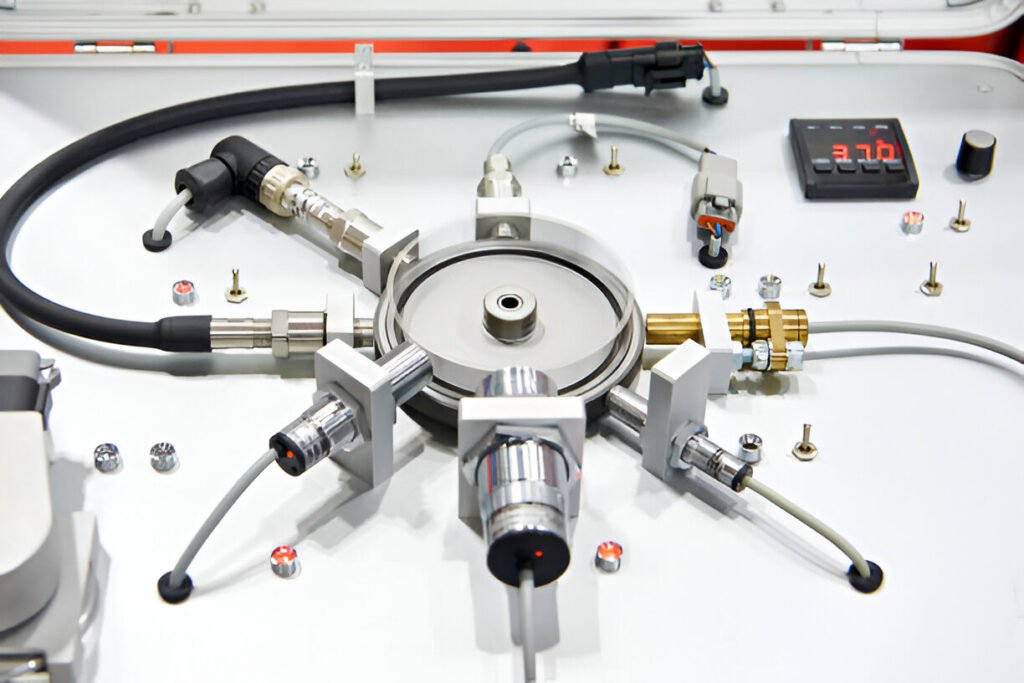静電容量式センサーは、スマートフォンの画面から産業機械に至るまで、いたるところにある。しかし、静電容量式センサーとは一体何なのでしょうか?この記事では、静電容量式センサーの世界を深く掘り下げる。 静電容量式センサーその原理と応用、そしてなぜ現代技術に大きな変化をもたらしたのかを探る。オタクになる準備はいいか?さあ、行こう!
静電容量式センサーとは?
静電容量式センサーは、静電容量の変化を検出するデバイスで、電荷を蓄えるシステムの能力である。導電性のもの(指など)が近づくと反応する、目に見えない小さな力場のようなものだと考えてほしい。これらのセンサーは、高感度で耐久性があり、物理的な接触を必要としないため、広く使用されている。
静電容量式センサーの仕組み
静電容量式センサーの核心は、静電容量の原理に依存している。センサーの電界に物体(指など)が入ると、静電容量が変化し、センサーがそれを検出する。これはセンサーと物体の間のダンスのようなもので、微妙で正確、そして信じられないほど速い。
静電容量式センサーの種類
表面容量センサー
このセンサーは1層の導電性材料でタッチを検出する。古いタッチスクリーンやキオスク端末によく見られる。
投影型静電容量センサー
より高度で精密なこのセンサーは、グリッド状の電極を使って複数のタッチポイントを同時に検出する。これが、スマートフォンの画面の反応性を高めているのだ!
静電容量式センサーの主要部品
典型的な静電容量式センサーは、以下のように構成されている:
導電層システム
デザイン構成:
- 制御可能な電界を発生させるためのインターデジタルまたはパラレル電極レイアウト。
- ITO()のような材料を使用したフレキシブル/透明バリアントインジウム・スズ酸化物)または銀ナノワイヤーを用いた。
パフォーマンスの最適化:
- 微細構造化された表面(レーザーエッチングされた溝など)はエッジフィールドの感度を高める。
- 3D空間フィールド制御のためのマルチレイヤースタッキング。
誘電体層システム
素材の選択:
- コスト重視の用途に適した標準的なポリマー(FR-4、ポリイミドなど)。
- 極限環境用の高-εセラミック(BSTなど)またはフッ素樹脂(FEPなど)。
構造改革:
- 非線形感度調整のための勾配誘電体層。
- 湿度/化学薬品に対する保護コーティング(窒化ケイ素など)。
信号処理ユニット
コア・コンポーネント:
- サブフェムトファラドの分解能を持つキャパシタンス-デジタル・コンバータ(CDC)。
- アナログ/デジタル信号調整用のプログラマブルMCU(PSoCなど)。
高度なアルゴリズム
- ドリフト補償、適応ノイズ・フィルタリング、多重化チャネル処理。
- プロトコルCAN FD、IO-Link、またはBLE 5.0による産業用IoT統合。
電源管理システム
エネルギー・ソリューション
- 低消費電力LDOレギュレータ(スタンバイ時1μA未満)またはエネルギーハーベスティング・モジュール。
- 消費電力を最小限に抑えるダイナミック電圧スケーリング。
安全メカニズム:
- 過電圧保護用TVSダイオード。
- IEC 61000-4-2に準拠したESD保護。

静電容量式センサーの用途
コンシューマー・エレクトロニクス
スマートフォンからスマートウォッチまで、静電容量式センサーは現代のガジェットの縁の下の力持ちだ。
産業オートメーション
正確な物体検出、レベル感知、さらにはロボットアームにも使われている。
ヘルスケアと医療機器
医療機器やウェアラブル健康モニターのタッチレス・インターフェースを考えてみよう。
静電容量式センサーの利点
- 高い感度と精度。
- 丈夫で長持ち。
- 接触する必要がないため、物理的な消耗がない。
静電容量式センサーの限界
- 湿度などの環境要因の影響を受けることがある。
- 他のセンサータイプに比べ範囲が狭い。
- 抵抗センサーより高価。
静電容量式センサーと抵抗式センサー:その違いは?
静電容量式センサーが静電容量の変化に依存するのに対し、抵抗式センサーは圧力を検出する。静電容量式センサーの方が応答性と耐久性に優れているが、抵抗式センサーの方が安価で、導電性のものだけでなくあらゆる物体に対応する。
静電容量式センサー技術の将来動向
より薄く、より柔軟なセンサー、改善されたマルチタッチ機能、よりスマートなデバイスのためのAIとの統合が期待される。
正しい静電容量式センサーの選び方
感度、サイズ、環境条件、コストなどの要素を考慮してください。お困りですか?専門家に相談するか、製品のデータシートを参照してください。
結論
静電容量式センサーは、スマートフォンから産業用ロボットまで、あらゆるものに電力を供給する、現代技術の目に見えない主力製品です。精密で耐久性に優れ、汎用性が高いため、数え切れないほどのアプリケーションに不可欠です。テクノロジーが進化するにつれ、静電容量式センサーも進化し、さらに革新的なソリューションへの道が開かれるでしょう。
よくあるご質問
静電容量式センサーはどのような物質を検出できますか?
静電容量式センサーは、主に人間の皮膚、金属、水などの導電性物質を検出する。
静電容量式センサーはガラスを通して機能するか?
そうだ!ガラス、プラスチック、木材のような非導電性素材を通してタッチを検知することができるのだ。
静電容量式センサーは水に影響されますか?
そう、特に高湿度の環境では、水が精度を妨げることがある。
静電容量式タッチスクリーンのクリーニング方法は?
マイクロファイバークロスと少量のイソプロピルアルコールを使用してください。刺激の強い化学薬品や研磨剤は避けてください。
静電容量式センサーは複数のタッチを検出できるか?
そう、特に投影型静電容量式センサーは、マルチタッチ機能用に設計されている。
以上、静電容量式センサーの完全ガイドでした!あなたが技術マニアであれ、単なる好奇心であれ、この記事がこれらの魅力的なデバイスに興味を持つきっかけになれば幸いだ。









